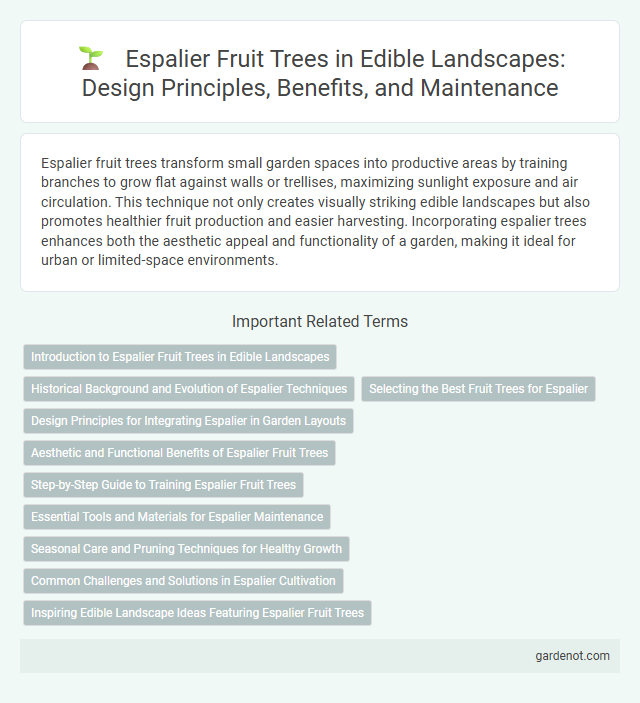Espalier fruit trees transform small garden spaces into productive areas by training branches to grow flat against walls or trellises, maximizing sunlight exposure and air circulation. This technique not only creates visually striking edible landscapes but also promotes healthier fruit production and easier harvesting. Incorporating espalier trees enhances both the aesthetic appeal and functionality of a garden, making it ideal for urban or limited-space environments.
Introduction to Espalier Fruit Trees in Edible Landscapes
Espalier fruit trees transform limited garden spaces into productive, visually appealing edible landscapes by training trees to grow flat against walls or trellises. This ancient horticultural technique maximizes sunlight exposure and air circulation, enhancing fruit yield and health. Integrating espaliered fruit trees in edible landscapes combines ornamental beauty with functional food production, ideal for urban gardens and small yards.
Historical Background and Evolution of Espalier Techniques
Espalier fruit trees date back to ancient Roman horticultural practices, where wall-trained trees were used to maximize sun exposure and save space in confined gardens. During the Renaissance, espalier techniques evolved with intricate patterns and formal designs promoted by European gardeners to enhance both aesthetics and fruit production. Modern espalier methods integrate traditional craftsmanship with contemporary pruning and training systems, allowing urban gardeners to cultivate productive, space-efficient edible landscapes.
Selecting the Best Fruit Trees for Espalier
Choosing the best fruit trees for espalier involves selecting varieties with naturally flexible branches and strong disease resistance, such as apple, pear, and quince. Dwarf or semi-dwarf rootstocks are ideal for controlling growth and maintaining manageable tree size, ensuring ease of training against a support structure. Prioritize cultivars that produce high yields in limited space and are well-suited to the local climate for optimal fruit production and longevity.
Design Principles for Integrating Espalier in Garden Layouts
Espalier fruit trees maximize space efficiency by training branches to grow flat against a support, creating structured, visually appealing vertical layers in garden layouts. Design principles emphasize strategic placement along walls or fences to optimize sunlight exposure and microclimates, enhancing fruit production and plant health. Integrating espalier within edible landscapes combines functionality with aesthetics, promoting sustainable gardening practices through efficient resource use and increased yield in limited spaces.
Aesthetic and Functional Benefits of Espalier Fruit Trees
Espalier fruit trees create visually striking vertical landscapes that maximize limited garden space while enhancing property aesthetics with their symmetrical, sculptural forms. These trees improve air circulation and sunlight exposure, promoting healthier fruit production and easier maintenance such as pruning and harvesting. Their unique design also serves as natural privacy screens or decorative boundaries, combining functionality with ornamental appeal in edible landscaping.
Step-by-Step Guide to Training Espalier Fruit Trees
Training espalier fruit trees involves selecting healthy young trees and pruning them to develop strong central leaders and horizontal branches. Begin by securing the main trunk to a support frame, then gradually tie new growth to horizontal wires spaced evenly apart to create the desired shape. Consistent pruning during the growing season encourages fruit production and maintains the tree's structural integrity while optimizing sunlight exposure.
Essential Tools and Materials for Espalier Maintenance
Essential tools for espalier fruit tree maintenance include pruning shears, a specialized grafting knife, and heavy-duty gloves to protect from thorns and sap. Materials such as sturdy trellises or wires, plant ties, and anti-fungal sprays are crucial to support the tree's structure and prevent disease. Regular use of these tools and materials ensures optimal growth, shape training, and fruit production in edible landscapes.
Seasonal Care and Pruning Techniques for Healthy Growth
Espalier fruit trees require precise seasonal care and pruning techniques to maintain healthy growth and maximize fruit production. During late winter or early spring, dormant pruning focuses on removing dead or crowded branches to improve air circulation and sunlight penetration. Summer pruning involves trimming vigorous shoots to balance growth and fruit development, promoting a strong framework and consistent harvest.
Common Challenges and Solutions in Espalier Cultivation
Common challenges in espalier fruit tree cultivation include managing pest infestations, ensuring proper pruning techniques, and maintaining balanced nutrient levels to promote healthy growth. Solutions involve integrated pest management strategies, precise summer and winter pruning to control shape and fruit production, and regular soil testing combined with targeted fertilization to support optimal tree health. Proper training of branches with supportive structures further improves air circulation and light penetration, reducing disease risks and enhancing fruit yield.
Inspiring Edible Landscape Ideas Featuring Espalier Fruit Trees
Espalier fruit trees transform small spaces into productive edible landscapes by training branches flat against walls or trellises, maximizing sunlight exposure and air circulation for healthier growth. Commonly grown varieties include apples, pears, and figs, which offer both aesthetic appeal and fresh, homegrown fruit. Integrating espalier fruit trees into garden design exemplifies sustainable food production while enhancing ornamental value and increasing fruit yield within compact urban settings.
Espalier fruit tree Infographic

 gardenot.com
gardenot.com